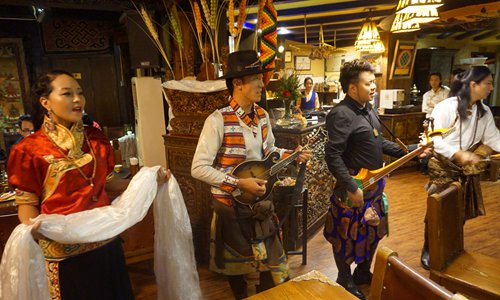
Hada is given to clients as a welcoming symbol in Makye Ame restaurant. (Photo/Courtesy of Hwang Hyerin)
No need to embark on a lengthy journey across snow-capped mountains to satisfy a craving for sliced yak tongue anymore. Foodies from near and far have been enjoying Tibetan food, culture and hospitality in the very center of China's capital.
"Not only is the food different and delicious, but everything feels so exotic here," said Li Zhang, a regular of Tibetan restaurant Makye Ame. "This place is just 30 minutes from my home, but it feels like I travelled 3,000 kilometers to Lhasa."
Established in 2001, Makye Ame is one of the oldest Tibetan restaurants in Beijing and one that honors the friendly traditions of the high plateau.
"Our staff is made of young Tibetan people who come from all three of China's Tibetan regions - Tibet, Qinghai and Sichuan provinces," said 24-year-old Mima Lhamo from Shigatse City, the Tibet Autonomous Region, who is staff manager of the restaurant. Dressed in a colorful national dress, she skillfully manages a team of young Tibetan cooks and waiters. "As for our clients, they come from everywhere, including Tibetan, Han people and foreigners."
Makye Ame is only one of the many Tibetan restaurants that have sprung up in recent years all over Beijing, catering to a small but growing customer base. In addition to taking guests on a unique culinary adventure, these restaurants have become platforms for highlighting Tibet's unique culture to residents of Beijing.
The authenticity dilemma
Founded in 2001 by Zelang Wangqing, a prolific entrepreneur from Aba Tibetan and Qiang Autonomous Prefecture, in western Sichuan, Makye Ame is renowned for providing a genuine culinary experience, even if it means unsettling customers who may not be used to Tibetan's love of meat and milk.
Lhamo, who was born and raised in Tibet, vouches for the authenticity. "The meat dishes are exactly what you can find in Tibet, same preparation and same taste," she said.
Reflecting Tibetan people's legendary carnivorous lifestyle, the menu is as meaty as it gets with dozens of yak and mutton dishes in all forms and sizes. Guests can quench their thirst with a cup of butter tea, Tibet's salty traditional drink, or with various kinds of highland barley liquors.
While fresh meat is sourced from the Inner Mongolia Autonomous Region, other ingredients, such as dairy products and dried yak meat, are flown in directly from Lhasa. "Most of the things we serve here are simply unavailable elsewhere in Beijing," Lhamo said.
The restaurant's insistence on providing authentic dishes, without trying to make them more palatable to local taste, is both commendable and risky. Some customers are visibly satisfied, others not as much. "Avoid the tasteless tsamba at all costs," reads one online review, referring to Tibetans' favorite staple food of roasted barley flour.
Qomolanga restaurant, another popular venue for Tibetan food in Beijing, has taken a different approach to authenticity.
Hidden deep in the heart of Beijing's hutong, not far from the tourist attraction Houhai, Qomolangma is located inside the Tibetan Autonomous Region's liaison office in Beijing. The restaurant mostly caters to tourists and families who are somewhat less tempted by daring culinary adventures.
Liu Hai, staff manager of the restaurant, explains that the restaurant had to adapt its taste to please local costumers, while offering typical Tibetan dishes like sheep head and fried ginger.
"We adapted most of our Tibetan food to Han people's taste by adding local spices, and since most of our cooks are Han people, about half of our menu consists of Sichuan food," she told Metropolitan.
Chinese clients looking for something different without overstepping their taste buds' boundaries have welcomed this localization. However, if this fusion of Sichuan dishes and Tibetan meat helped the restaurant gain new clients, others remain more skeptical.
"When Tibetan officials and leaders come to the capital and visit our restaurant, they usually just drink butter tea and then eat elsewhere," said Liu. "They say it's not real Tibetan food."


















































